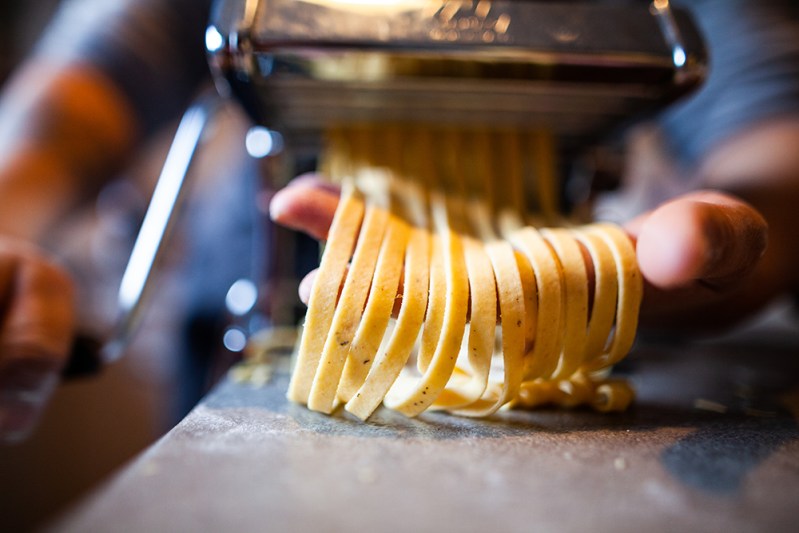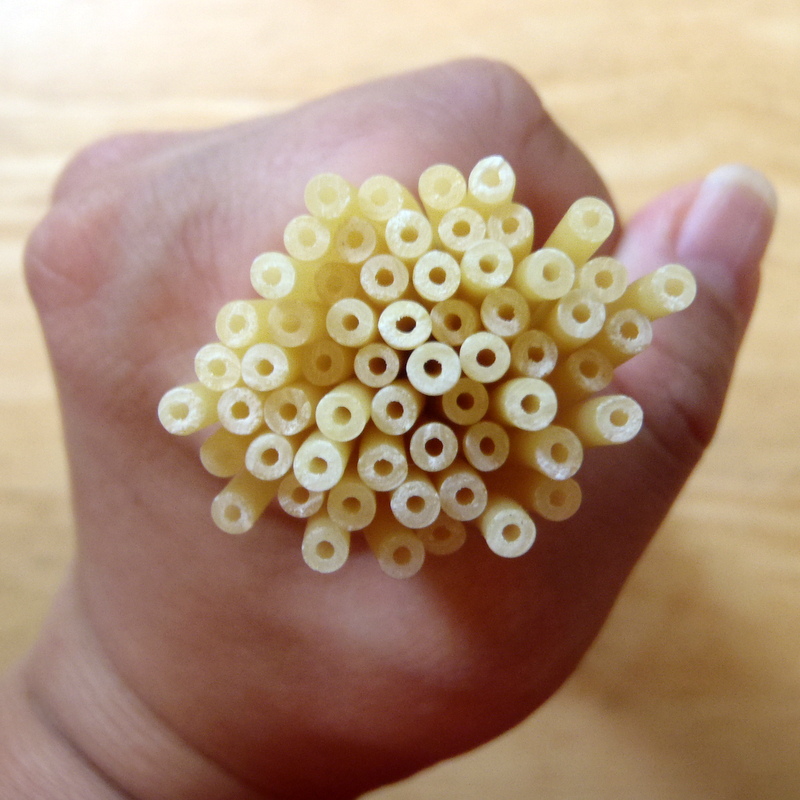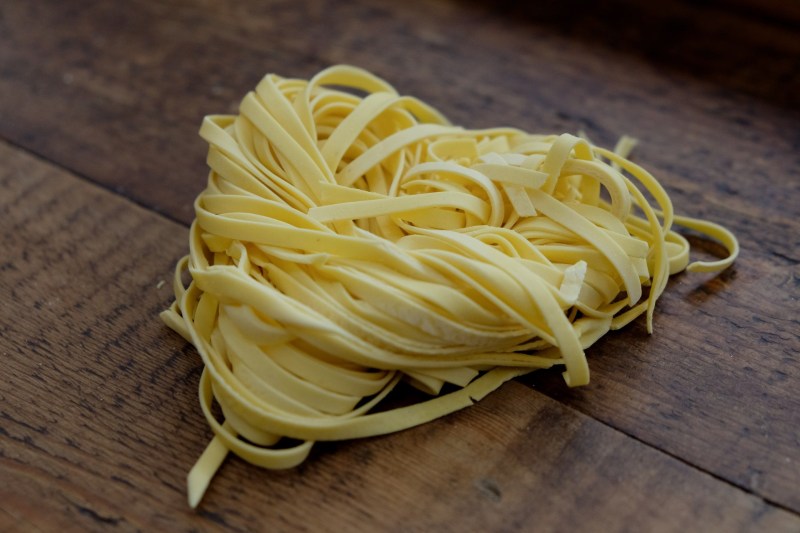In this country, we rarely consider the act of making pasta. It’s something we purchase prepared, allowing us to focus on other things, like a good sauce or side dish. Yet, there’s hardly a tradition more rewarding to pursue in the kitchen than making your own pasta from scratch. No, it’s not the easiest culinary act in the book, but it is a fun, approachable, and decidedly Italian one. Plus, you can brag to your dinner date or guests that you mixed, cut, and cooked the noodles yourself.
With a steady pair of hands and a little baking prowess, just about anybody can prepare homemade pasta. What’s more, you can fool around with different styles and even opt for healthier versions and learn how to make pasta from whole wheat. The task can be even more enjoyable with a good playlist and a glass of something good and pasta-friendly, like Chianti. What’s you’ve twisted your fork into a fresh batch, you may never go back to the prepared stuff.
The basics

Think of pasta like you do bread. It’s made from dough, preferably on the malleable side with the right ratio of flour types. We like the recipe below from Bon Appétit. It’s technically meant for ravioli, but it’s a flexible recipe that can work with just about any kind of pasta.
Go into the routine patient, knowing that the turnaround for the homemade stuff isn’t exactly quick. Be willing to take a few stabs at the dough, as you’ll find you’ll like various hydration levels better depending on what kind you’re making. The same can be said with egg yolk content. Trial and error is best here, so don’t feel like you need to knock your first batch out of the park.
When it comes time to cook the pasta, be at the ready. Being fresh, it will cook much faster than the dried stuff, so have your plates, tongs, and colander ready for what feels like a flash boil. And don’t drown your first effort in sauce. In fact, try some on its own once it cools to see how it differs and how it might be improved next time (perhaps more salt or a different flour bill for a changed texture).
Ingredients:
- 3 large eggs, beaten to blend
- 2 cups all-purpose flour
- 1 tablespoon olive oil
- 1 teaspoon kosher salt
Method:
- Mix the eggs, flour, oil, and salt in the bowl of a stand mixer with your hands until a shaggy dough forms.
- Knead with the dough hook until the dough is smooth and elastic, about 10 minutes.
- Cover the dough with plastic wrap and let it rest for at least 30 minutes.
- Cut and roll as desired.
- Do ahead: Dough can be made 1 day ahead — tightly wrapped and chill.
Equipment
Essentially, you’ll need a few staples when making pasta. Down the road, once you’ve become an expert, you can add bells and whistles like specialized drying racks. But for your first stab, you can just start with a solid mixer for preparing your dough.
For starters, you’ll need a decent roller, and because flour and eggs are in the picture, a good apron. If you’re making pasta with a specific shape, you’ll need a special cutter (if you’re making ravioli, for example, you’ll want something like this). You’ll also need a pasta roller, which feels like an impulse buy until you make a batch and get hooked. We like this very traditional Marcato Atlas machine, as well as this sleek and more modern Ovente manual pasta maker. You’ll also want a good tray. Most pros recommend glass versus metal for even baking and less sticking to the pan.
If you don’t want a full roller, you can get away with a decent chef’s knife and some precise cutting. You can also often get away with a decent rolling knife, such as a pizza cutter.
Pasta types

Pasta is practically its own language. There are many, many variations. For our purposes, we’ll focus on some of the more common kinds to make at home. Although, if you’re feeling innovative and want to make your own orecchiette as they do in southern Italy, be our guest.
Your go-to for most pasta is spaghetti and pappardelle. The former is stringy and a pretty standard size, while the latter is wider, sturdier, and more photogenic, great with more involved recipes. We love bucatini, which is essentially a thicker spaghetti noodle with a hole running through it. Linguini and fettuccine are pretty much in the same family.
Cavatelli looks like little ears and can be made with a little practice and your thumbs for a tool. For more varieties and a visual companion, check out this video. Smaller, tube-like pasta, such as ziti and penne, require some delicate rolling (and a thin roller for evenness), while more decorative pasta, like farfalle (also known as bow tie), requires a special pinch. No matter what direction you go, it’s hands-on fun, and even the lesser-looking stuff will taste great.
What are the best pasta sauces to make with homemade pasta noodles?

Homemade pasta pairs beautifully with a variety of sauces, allowing the fresh flavors to shine through your homemade pasta noodles. Here are some of the top contenders for you to consider after making the noodles.
- Simple tomato sauce: This classic sauce is a great way to showcase the quality of your homemade noodles. Use fresh, ripe tomatoes, garlic, olive oil, and fresh basil for a quick and flavorful sauce.
- Pesto sauce: This vibrant green sauce is packed with flavors, from fresh basil and garlic to pine nuts and Parmesan cheese. It’s a versatile sauce that can be tossed with hot pasta or used as a filling for ravioli.
- Lemon butter sauce: This light and refreshing sauce is perfect for summer. It’s made with butter, lemon juice, garlic, and fresh parsley. It’s a simple yet elegant accompaniment to fresh pasta.
- Bolognese sauce: This rich and meaty sauce is a slow-cooked masterpiece. It’s made with ground beef, pork, pancetta, tomatoes, red wine, and vegetables. The long cooking time allows the flavors to develop and meld beautifully.
- Carbonara sauce: This creamy and decadent sauce is made with eggs, Parmesan cheese, pancetta, and black pepper. It’s quick and easy, perfect for any weeknight meal.
- Alfredo sauce: This classic sauce is made with butter, heavy cream, Parmesan cheese, and black pepper. It’s a rich and luxurious sauce that’s perfect for a special occasion for your homemade noodles.



